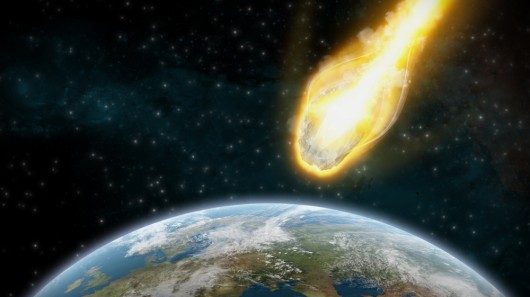Asteroid deflection schemes go green with solar-powered laser spacecraft
By Jan Belezina
14:17 June 18, 2012

Scientists are proposing that spacecraft could use solar-powered lasers to deflect an Earth-bound asteroid (Image via Shutterstock)
The threat of an asteroid hitting our home planet may not an immediate one, but it better be tackled before it becomes imminent. The brief visit of the 99942 Apophis asteroid in 2004 served as a reminder that a collision with Earth is by all means possible. Scientists have been working on a solution since then, and several bold plans were hatched. The latest one comes from Massimiliano Vasile and Christie Maddock from the University of Strathclyde in Scotland, who reckon we should build a spacecraft fitted with solar-powered lasers.
Blowing a 46 million tonne (50.7 million ton) asteroid into pieces with lasers would be difficult, but that won’t be necessary. The goal here, instead, would be to ablate some of the asteroid's surface and steer it away from us as a result. As material is vaporized from the asteroid’s surface, it generates thrust and propels the asteroid away from its original course. "[Our] paper demonstrates how significant deflections can be obtained with relatively small sized, easy-to-control spacecraft," say Vasile and Maddock.
Although the idea in itself is not new, scientists previously believed that only a megawatt laser could do the job, and a supply of nuclear power would be necessary. Launching a nuclear power station into space would be neither safe nor practical, with heat management being the most prominent problem. The new design does away with this problem by proposing to replace one very powerful laser with several smaller, sun-powered ones. Additionally, the smaller, kilowatt-class lasers require no fuel, and are simpler and safer to operate.
Also, investing our hopes into one massive laser is like putting all our eggs in one basket. An array of independent lasers, on the other hand, leaves more room for error ... and in such a hostile environment, we cannot just assume everything will go smoothly. For one thing, the material removed from the asteroid’s surface could block the lasers and diminish their effectiveness. Orbiting further away from the asteroid would solve the problem, but then mirrors used to focus the rays of sun onto the surface might not work.
The different lasers beams could be collimated in order to allow aiming from further away, thus reducing the risk of blocking the spacecraft optics. But, even if that problem is solved, there remains the matter of asteroids with orbits that are too far removed from the Sun to provide a continuous supply of the necessary solar energy. However, Vasile and Maddock reckon that even then, their design should be able to muster enough of a blast to steer Apophis away from the blue planet.
It is not yet clear how the plan compares to other proposed solutions, such as using a nuclear bomb, a gravitational tractor (deflecting the asteroid through speeding it up using solely the spacecraft’s own mass and its gravitational field) or provoking a kinetic impact. Nor is it clear how much money a deflection mission ran according to Vasile and Maddock’s plan would cost. What we do know, however, is that we cannot afford to pay the price in human lives, should an Earth-bound asteroid catch us unprepared.
Source: University of Strathclyde via technologyreview
Copyright © gizmag 2003 - 2012 To subscribe or visit go to: http://www.gizmag.com